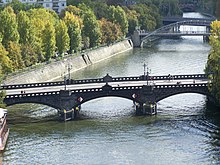Mayen basalt lava


Mayen basalt lava is a trade name for a rock that is primarily mined in the Mayen mine field near Mayen in the Eastern Eifel in Rhineland-Palatinate . This volcanic rock, scientifically known as leucite - tephrite , was formed in the Quaternary .
geology
The Vulkaneifel is divided into the Hocheifel , West and East Eifel . The oldest volcanic eruptions took place around 45 to 24 million years ago in the Hocheifel. In the West Eifel, volcanism began again 700,000 years ago with the formation of cinder cones and maars . Volcanic activity began in the Eastern Eifel 500,000 years ago. Between 450,000 and 350,000 years ago, huge amounts of pumice and volcanic ash were ejected in the Rieden area , creating several tuffs. The last major volcanic eruption took place in the Eifel around 13,000 years ago at Lake Laacher . After that there was only one minor eruption that led to the formation of the Ulmener Maar 11,000 years ago .
Mayen basalt lava was formed 200,000 years ago when the Bellerberg volcano erupted . In addition, the Mendiger basalt lava near Mendig and the basalt lava Plaidt (a basanite ) near Plaidt were also formed .
Rock description and mineral inventory
The Mayen basalt lava is colored light gray-blue. It shows relatively evenly distributed bubble-shaped pores and there are isolated white, gray and green insects. The maximum pore size is 5 mm.
The solid components are 70 percent and the visible pore space is 30 percent. The fine-grained matrix consists of 93 percent ( Aegirin-augite , titanaugite , leucite , plagioclase , Nosean , magnetite , corundum , zircon and opaque components). The inclusions of pyroxene , leucite, nosean and rock fragments amount to 7 percent.
use
Mayen basalt lava is extremely weatherproof and frost-resistant. This basalt lava has been used on numerous buildings in the Mayen area for masonry blocks for solid buildings, floor and stair coverings, window sills, door frames and window cornices, facade panels , grave monuments and stone carving work. The basalt lava is resistant to frost and de-icing salt and is particularly suitable for non-slip stair and floor coverings outdoors.
Basalt lava was mined as early as the time of ancient Rome and up to 600 people are said to have been involved in the dismantling of grinding stones and grinding stones near Mayen. Numerous basalt crosses were set up around Mayen in the Middle Ages and this stone was built into Cologne Cathedral as early as 1830 due to its durability.
Symposium
A sculpture symposium with Mayen basalt lava and other regional rocks was held in Mayen from 1985 to 2006 under the title "Lapidea".
Similar rocks
- Mendiger basalt lava near Mendig (Eifel in Rhineland-Palatinate)
- Basaltite near Bolsena ( Umbria in Italy)
Individual evidence
- ↑ Hans-Ulrich Schmincke: Vulcanism . Scientific Book Society, Darmstadt 2000, ISBN 3-534-17471-2 .
- ↑ State Office for Geology .
- ↑ Wolf-Dieter Grimm, picture atlas of important memorial rocks of the Federal Republic of Germany , rocks no. 033, ed. from the Bavarian State Office for Monument Preservation, Lipp-Verlag. Munich 1990, ISBN 3-87490-535-7 .
- ↑ Information on www.s-zukunft.de , accessed on September 24, 2009.
- ↑ Cologne Cathedral website ( Memento of the original from September 24, 2009 in the Internet Archive ) Info: The archive link was inserted automatically and has not yet been checked. Please check the original and archive link according to the instructions and then remove this notice. , accessed September 22, 2009.
- ^ Website of the symposia of the Lapidea Association , accessed on September 24, 2009.

